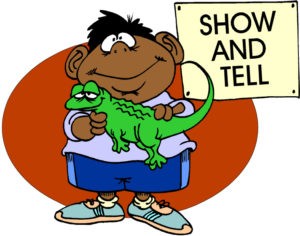How to revise in fiction for too much telling, not enough showing: “before” and “after” examples

My intro as published earlier… I try to post each Wednesday.
The bad news is that my latest manuscript has been gathering rejections. The good news is that the rejections have come with consistent feedback. That’s rare and highly useful, and therefore something to appreciate as I, by necessity, must now transition from writing to revision mode.
According to those who dared to reject me (hey, it does feel like a stomach punch the first week!), I have three weaknesses in this not-yet-up-to-snuff young-adult novel:
1. My protagonist is a little on the “morose” side, and I need to jolly him up, give him a more upbeat and distinctive “voice.” In other words, lighten up!
2. Some of my teen dialogue and expressions are “outdated.” (Now there’s a tricky accusation, given how fast expressions change, and how slang can be regional, even cultural.) In other words, stay current with teen talk.
3. My first-person narrator sometimes uses over-sophisticated words, or doesn’t talk like a normal teen. This is a sin I committed not during dialogue (I know better) but during description/narration paragraphs, when it feels okay to slip into my own way of speaking. Yet having opted for a first-person teen point of view (POV), all narration (not just dialogue) has to be in his voice, which means his vocabulary level and type of expressions. It’s something I hadn’t really thought about, and needed to be told, so I hope it helps others reading this. In other words, keep POV consistent in dialogue and narration.
4. In places, there is too much telling, not enough showing. What?! After 17 published books, I can still have that one leveled at me? Evidently so!
Now that I’m nearly completed my revisions, I’ve decided to spend a blog each on these four lessons. Today’s is No. 4. For each, I share “before” and “after” passages, so you can see the differences I’ve made during weeks of back-breaking revisions. Call it Fiction Writing 201, but it’s useful perspective if it helps save you from the “ouch” of rejections.
Before and after examples:
BEFORE: I hesitate. “Yes.”
AFTER: I purse my lips to seal all emo inside. “Yes.”
BEFORE: “Uh-huh,” I say politely.
AFTER: “Uh-huh,” I say, forcing my eyes to meet hers. “I’m fine,” I add, fingernails pressing into my palms.
BEFORE: As the pot comes to a boil…
AFTER: As the pot bubbles fiercely…
BEFORE: Her eyes look a bit wild.
AFTER: Her pupils look ready to pop out.
BEFORE: The stream through which we’re slogging in the ever-steadier rainfall is getting treacherously deep.
AFTER: The stream section through which we’re slogging in the ever-steadier rainfall has risen to thigh-chilling deep.
BEFORE: She’s ignoring his perplexed, panicked look.
AFTER: She’s ignoring his dropped jaw.
BEFORE: The walls narrow and the water turns deeper and swifter.
AFTER: The walls narrow and the water turns deeper and swifter. I breathe in the earthy smell of moss and enjoy its almost electric green glow on surrounding boulders.
BEFORE: It takes me a moment to recover from the shock of that.
AFTER: My heart stops. “Huh?”
BEFORE: “Ever done Swallow Canyon?”
That question again. “The Upper Canyon a thousand times.” Well, a hundred, anyway. Nothing wrong with being proud of that, right?
“And the Lower Canyon?”
I should’ve seen it coming, but stiffen anyway.
AFTER: “Ever done Swallow Canyon?”
That question again. “The Upper Canyon a thousand times.” Well, a hundred, anyway. I lift my chin as I say it.
“And the Lower Canyon?”
My chin sinks.
BEFORE: They’re nervous novices at the sport if ever I’ve met any, judging from the questions they pepper Brigit and Alex.
AFTER: Definitely nervous novices, I decide, overhearing the questions with which they pepper poor Brigit and Alex:
“How long is this canyon hike?
“If we get scared, can we turn back?”
“You’ll show us how to put on all this gear, right?”
“Why do we have to wear helmets?”
“Just checking, but you said we’d be back before dark?”
BEFORE: We gather ourselves around Brigit for the safety talk. She gives us each whistles to tie to our helmets, and lifts her own to demonstrate that three clear blasts means an emergency, and one long one means it’s all clear. She checks that each of us has a sheathed knife for cutting rope in an emergency.
AFTER: Brigit calls, “Over here, everyone! Gather around. Safety talk time!”
I lope over.
“First, I’m giving you each a whistle,” she says.
“Got my own,” I let her know.
“Me too,” Dominik says.
Our guide bristles and ignores us. “Tie it to your helmet. It allows us to communicate. If you hear three strong blasts in a row” – she puts lips to whistle and all but shreds our eardrums — “that means there’s an emergency. So stop and wait for instructions. One long blast” – my hands clamp on my ears just in time — “that’s the all-clear signal. Got it?”
“Got it,” Harry says.
She dips her hands into a bag. “I have several sheathed knives here, one for each of you. I’ll help you attach them onto your—”
“Have my own,” Dominik speaks up.
“Me too,” I say as politely as I can.
“—belts, so in the unlikely event of an emergency, you can cut tangled ropes that need cutting.”
BEFORE: Everyone searches their backpacks for their harness, a friction device and carabiners, and Brigit gives us a thorough talk and demonstration. She explains that there are two ropes for the group, one that’s twice the length of the longest rappel required, and one for emergency backup. She carries one and Dominik the other. That way, not only does neither person have too heavy a pack, but if one pack escapes down the creek, the group still has a rappel rope. We also each have shorter rescue ropes enclosed in throw-bags, which can be used for rappelling in an emergency. Finally, she emphasizes the need to not trust old anchors that we come across, since floods that have washed down between their setup and now can make them unreliable.
AFTER: Everyone searches their backpacks for their harness, a friction device and carabiners, and Brigit launches into a new talk and demonstration.
“We have two ropes on this hike. One is twice the length of the longest rappel we’ll be doing, and the other is our emergency backup. I’ll be carrying one. Dominik, I’m assigning you to carry the other.”
“Whatever you say,” he says cheerfully.
“That way,” she explains, “neither he nor I have to carry too heavy a pack. Also, if one pack escapes down the creek, we still have a rappel rope.”
“Good thinking,” I say.
“Each of us is also carrying shorter rescue ropes enclosed in throw-bags, also good in an emergency,” Brigit adds.
“What if other canyoneers have left a rope all set up?” Harry asks.
“Excellent question. Be very careful about trusting old anchors, because floods that have washed down since they were set up can make them unreliable.


